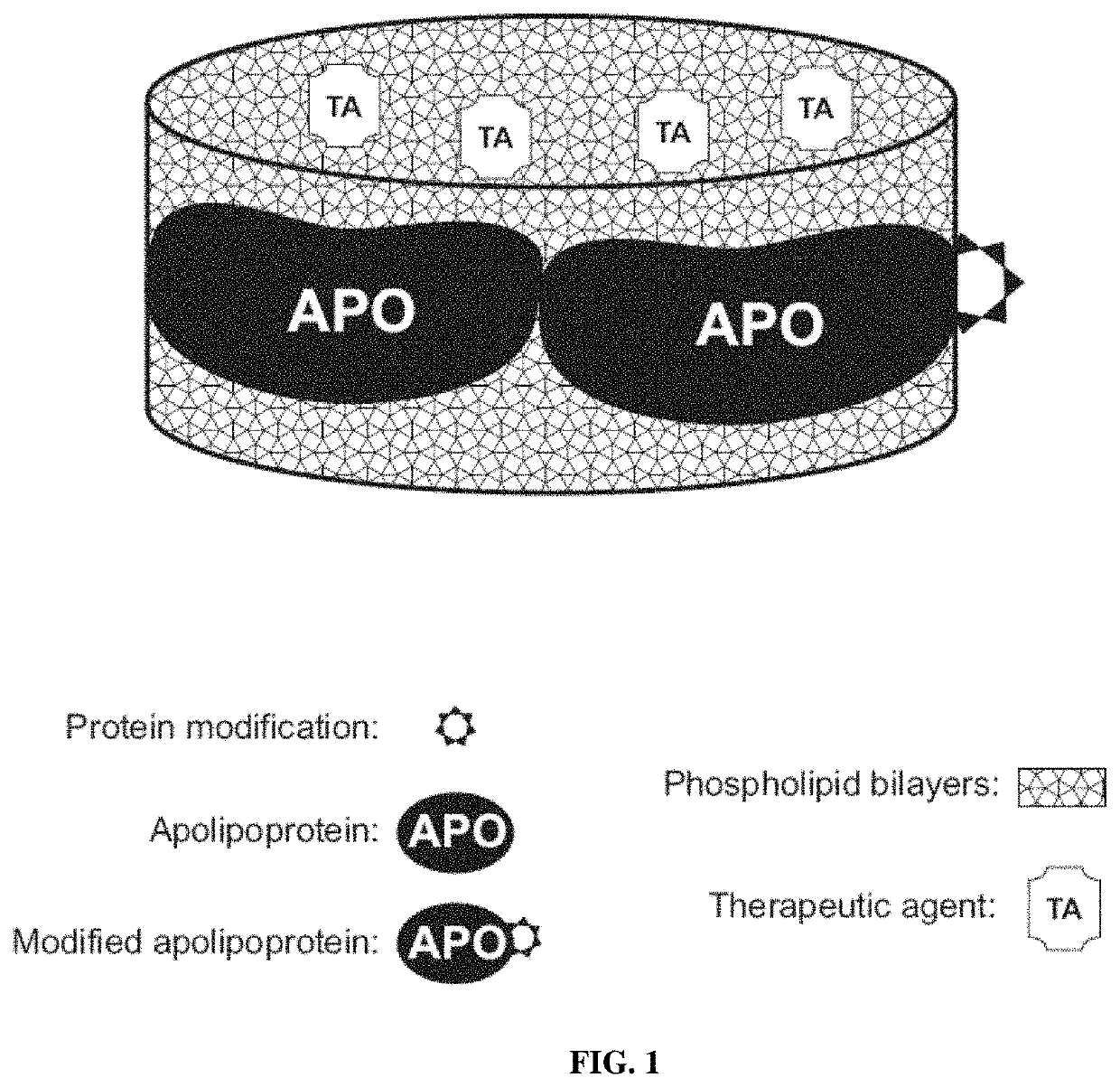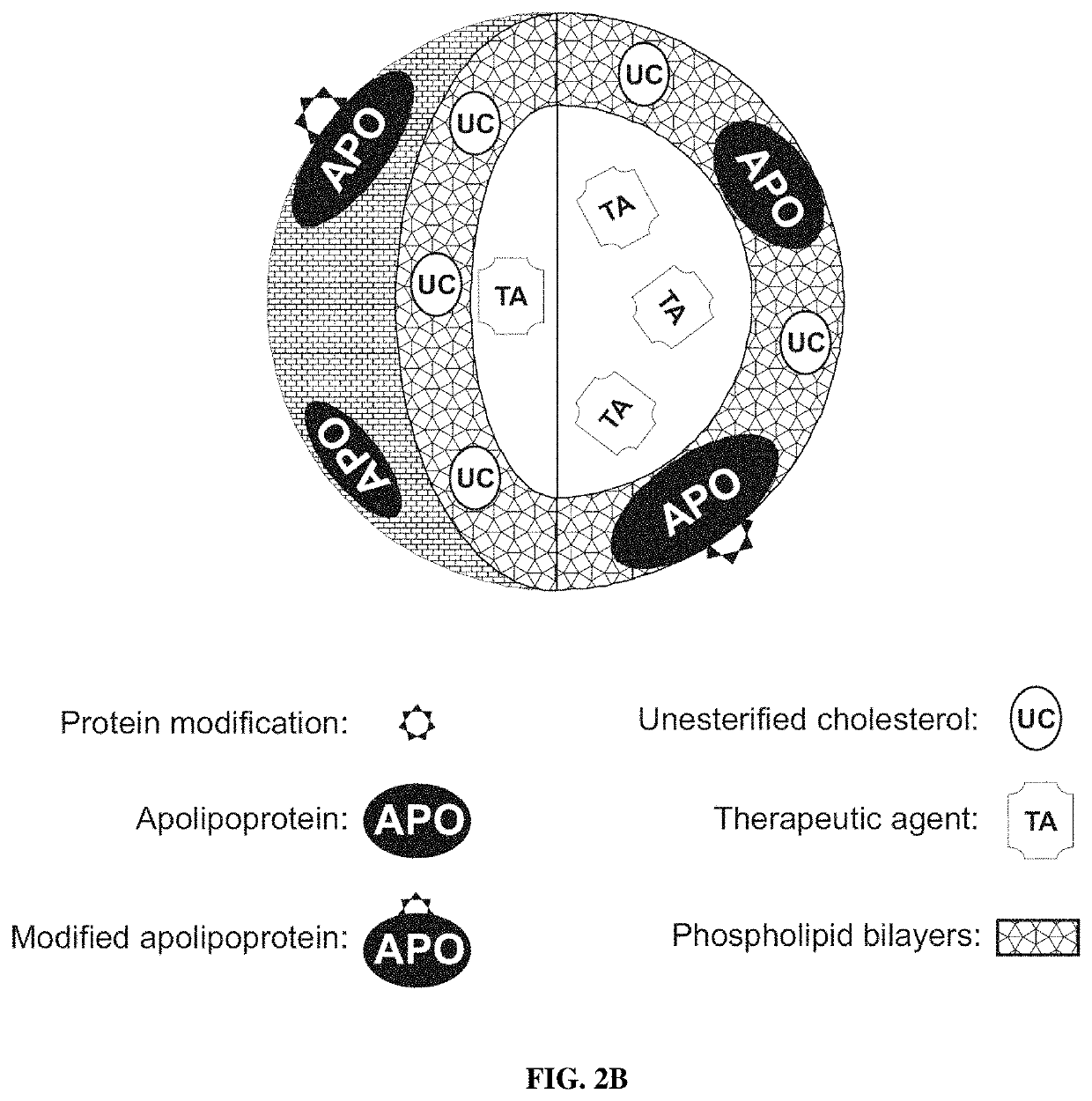Methods and compositions for targeted delivery of protein fragments
- Summary
- Abstract
- Description
- Claims
- Application Information
AI Technical Summary
Benefits of technology
Problems solved by technology
Method used
Image
Examples
example 1
Methods of Reconstitution and Characterization of Reconstituted HDL
[0197]As described in Oda et al. J Lipid Res 2006; 47:260-7 and disclosed in PCT Pat Appl PCT / US10 / 52117, U.S. Pat. Nos. 6,306,433, 7,824,709 and 6,514,523; US Pat Apps 20090110739 and 20070243136, the standard methods well known in the art can be used to reconstitute HDL as spherical or discoidal particles using the purified apo A-I and A-II as well as peptide fragments thereof, lipids and therapeutic and / or imaging agents. The standard procedures of HDL purification and characterization are also well-known in the art. It should be understood by those of ordinary skill in the art that any of the purified unmodified and modified apo A-I and A-II as well as peptide fragments thereof described herein and in PCT Pat Appl PCT / US10 / 52117 can be used to produce the compositions of the present invention. However, it is critical for the rHDL of the invention that the rHDL prepared should contain at least one modified molecul...
example 2
Production of Lipoprotein Apolipoprotein A-1 (LpA-I)-Therapeutic Agent Complexes
Preparation of Spherical LpA-I-Paclitaxel Complexes
[0200]As disclosed in US Pat Appl 20090110739, the particles are prepared by a process involving cholate dialysis to produce a spherical structure with the pharmaceutical enclosed in the interior hydrophobic core region. The lipid mixture (egg yolk phosphatidylcholine (PC), cholesterol and cholesteryl oleate in the ratio of 3.8:1:88.5) and 2 mg paclitaxel (PTX) is dried under nitrogen gas to a thin film and dispersed in dimethylsulfoxide and subsequently in 1.4 ml of 10 mM Tris, 0.1 M KCl, 1 mM EDTA, pH 8.0). Then, 140 ul of sodium cholate (100 mg / ml stock in [0.15 M NaCl 0.003 M KCl, 0.15 M potassium phosphate, pH 7.4, designated as PBS, phosphate buffered saline]) is added to produce mixtures with a final PC to cholate molar ratio of −1:1.6. Apo A-I (12.7 mg / ml) in 0.4 ml of PBS is added to this mixture and the final volume is adjusted to 2 ml with PBS...
example 3
Use of Spherical LpA-I-Paclitaxel Complexes
[0205]As disclosed in US Pat Appl 20090110739, the cytotoxic effect of the LpA-I-PTX preparations on cancer cells can be assessed by the methyl thiazol tetrazolium (MTT) assay. Briefly, cells are plated in 96-well plates (5000 cells / well) in their respective media. Next day, the monolayers are washed with PBS (pH 7.4) twice, and then incubated at 37° C. for 24 h with the LpA-I-PTX complexes in serum-free media. The following day, 25 ml of MTT (1 mg / ml) is added to each well and incubated for 3 h at 37° C. Plates are centrifuged at 1200 rpm for 5 min. The medium is removed, the precipitates are dissolved in 200 ml of DMSO and the samples are read at 540 nm in a microtiter plate reader.
Animal Toxicity
[0206]As disclosed in US Pat Appl 20090110739, female C57BL6 mice (6-8 weeks, 18-21 g) can be used in toxicity studies of LpA-I-PTX particles. Groups of six mice each receives injections of 1.5 ml of PBS via the intraperitoneal route,...
PUM
| Property | Measurement | Unit |
|---|---|---|
| Diameter | aaaaa | aaaaa |
| Diameter | aaaaa | aaaaa |
| Composition | aaaaa | aaaaa |
Abstract
Description
Claims
Application Information
 Login to View More
Login to View More - R&D
- Intellectual Property
- Life Sciences
- Materials
- Tech Scout
- Unparalleled Data Quality
- Higher Quality Content
- 60% Fewer Hallucinations
Browse by: Latest US Patents, China's latest patents, Technical Efficacy Thesaurus, Application Domain, Technology Topic, Popular Technical Reports.
© 2025 PatSnap. All rights reserved.Legal|Privacy policy|Modern Slavery Act Transparency Statement|Sitemap|About US| Contact US: help@patsnap.com



